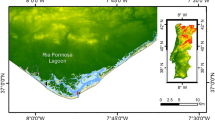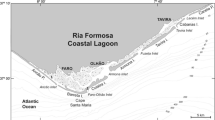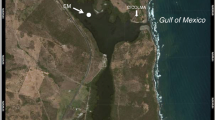Abstract
A combination of enclosure nutrient enrichment experiments and historical data analysis was used to identify the factors controlling seasonal dynamics and competition of the phytoplankton community in the Curonian lagoon (Southeast Baltic Sea). Experiments using different nutrient (N, P and Si) manipulations were performed in 10-l enclosures for 48 h. Changes in chlorophyll a concentrations, inorganic nutrient concentrations, and plankton cell density were monitored. Results revealed that phytoplankton development in the lagoon is strongly affected by ambient physical factors (wind, temperature). Nutrient limitation, however, also plays an important role in seasonal succession mechanisms showing quite distinct seasonal development patterns. Based on the data, available phytoplankton seasonal succession in the Curonian lagoon could be described as composed by three phases corresponding to different domination and regulatory mechanisms.
Similar content being viewed by others
References
F. J. Aldridge C. L. Scheske H. J. Carrick (1993) ArticleTitleNutrient limitation in a hypereutrophic Florida lake Archiv für Hydrobiologie 127 21–37
P. Bukaveckas W. Shaw (1998) ArticleTitlePhytoplankton responses to nutrient and grazer manipulations among northeastern lakes of varying pH Canadian Journal of Fisheries and Aquatic Sciences 55 958–966 Occurrence Handle10.1139/cjfas-55-4-958 Occurrence Handle1:CAS:528:DyaK1cXkslOhtr8%3D
D. J. Conley (1999) ArticleTitleBiogeochemical nutrient cycles and nutrient management strategies Hydrobiologia 410 87–96 Occurrence Handle10.1023/A:1003784504005
C. F. D’Elia J. G. Sanders W. R. Boynton (1986) ArticleTitleNutrient enrichment studies in a coastal plain estuary: phytoplankton growth in large-scale, continuous cultures Canadian Journal of Fisheries and Aquatic Sciences 43 397–406 Occurrence Handle1:CAS:528:DyaL28XitlSjs7Y%3D
T. R. Fisher E. R. Peele J. W. Ammerman L. W. Harding (1992) ArticleTitleNutrient limitation of phytoplankton in Chesapeake bay Marine Ecology Progress Series. 82 51–63
Fisher, T. R., J. M. Melack, J. U. Grobbelaar & R. W. Howarth, 1995. Nutrient limitation of phytoplankton and eutrophication of inland, estuarine, and marine waters. In Tiessen H. (ed), Phosphorus in the Global Environment – Transfers, Cycles and Management, SCOPE 54: 301–323
B. Gailiušis (2000) The analysis of hydrometeorological regime and hydraulic environment L. L. Lazauskienė G. Vaitonis A. Draugelis (Eds) Klaipėda port Economy and Ecology (in Lithuanian) Baltic ECO 37–48
Z. Gasiūnaitė A. Razinkovas (2000) ArticleTitleThe role of plankton and nektobenthos crustaceans in the fate of primary production in the Curonian lagoon (in Lithuanian) Ekologija 3 22–27
Z. R. Gasiūnaitė A. Razinkovas (2004) ArticleTitleTemporal and spatial patterns of the crustacean zooplankton dynamics in transitional lagoon ecosystem Hydrobiologia 514 139–149
Z. R. Gasiūnaitė I. Olenina (1998) ArticleTitleZooplankton-phytoplankton interactions: a possible explanation of the seasonal succession in the Kursiu Marios lagoon Hydrobiologia. 363 333–339
HACH, 1992. Water Analysis Handbook. Loveland, Colorado, USA, 400–407, 537–543 pp
Hägerhäll-Aniansson, B. (ed), 2001. Nitrogen fixation in the Baltic Sea. Brief guide for environmental managers, University of Kalmar, Vol. 1
R. E. Hecky P. Campbell L. L. Hendzel (1993) ArticleTitleThe stoichiometry of carbon, nitrogen, and phosphorus in particulate matter of lakes and oceans Limnology and Oceanography 38 709–724 Occurrence Handle1:CAS:528:DyaK2cXit1GqtLw%3D Occurrence Handle10.4319/lo.1993.38.4.0709
HELCOM, 1988. Biological determinants. Guidelines for the Baltic monitoring programme for the third stage. Part D. 27D, 164
Hutchins, D. A., 1995. Iron and the marine phytoplankton community. In Round F. E., D. J. Chapman (eds), Progress in Phycological Research, Biopress Ltd. 11: 1–49
B. W. Ibelings S. C. Maberly (1998) ArticleTitlePhotoinhibition and the availability of inorganic carbon restrict photosynthesis by surface blooms of cyanobacteria Limnology and Oceanography 43 408–419 Occurrence Handle1:CAS:528:DyaK1cXktFOqs7o%3D
T. Kawaguchi A. J. Lewitus C. M. Aelion H. N. McKellar (1997) ArticleTitleCan urbanization limit iron availability to estuarine algae? Journal of Experimental Marine Biology and Ecology 213 53–69 Occurrence Handle10.1016/S0022-0981(97)00009-9 Occurrence Handle1:CAS:528:DyaK2sXjsFyhtLs%3D
E. Kocum D. B. Nedwell G. J. C. Underwood (2002) ArticleTitleRegulation of phytoplankton primary production along a hypernutrified estuary Marine Ecology Progress Series 231 13–22
K. Kononen (1992) ArticleTitleDynamics of the toxic cyanobacterial blooms in the Baltic Sea Finnish Marine Research 261 3–36
M. Köster H.-D. Babenzien H. J. Black S. Dahlke S. Gerbersdorf J. Meyercordt L.-A. Meyer-Reil T. Rieling I. Stodian A. Voigt (2000) Significance of aerobic and anaerobic mineralization processes of organic carbon in sediments of a shallow coastal inlet in the southern Baltic Sea B. W. Flemming M. T. Delafontaine G. Liebezeit (Eds) Muddy coast dynamics and resource management Elsevier Science B. V Amsterdam 185–194
Krylova, O. I., 1985. Functioning Ecological Differences of Plankton and Benthos in the Kursiu and Vistula Lagoons of the Baltic Sea. (in Russian) Kaliningrad, AtlantNIRO, 224 pp
K.-E. Lindenschmidt I. Chorus (1998) ArticleTitleThe effect of water column mixing on phytoplankton succession, diversity and similarity Journal of Plankton Research 20 1927–1951
MRC, 1996. Annual report of scientific work. Center of Marine research, Environmental Protection Ministry. 94 pp
MRC, 1999. Results of hydrologic, hydrochemic and hydrobiologic investigations in Curonian lagoon during 1998. Centre of Marine research, Environmental Protection Ministry. 120 pp
Olenina, I., 1997. Phytoplankton and its developpment in the South-Eastern coastal Baltic and the Curonian lagoon, Doctoral dissertation thesis (in Russian). Vilnius, 161 pp
I. Olenina (1998) ArticleTitleLong-term changes in the Kursiu Marios lagoon: eutrophication and phytoplankton response Ekologija 1 56–65
Oliver, R. L. & G. G. Ganf, 2000. Freshwater blooms. In B. A. Whitton & M. Potts (eds), The Ecology of Cyanobacteria. Their Diversity in Time and Space, Kluwer Academic Publishers: 149–194
T. R. Parsons (1982) The future of controlled ecosystem enclosure experiments G. D. Grice M. R. Reeve (Eds) Marine Mesocosms. Biological and Chemical Research in Experimental Ecosystems Springer-Verlag New York 411–418
Pilkaitytė, R., 2003. Phytoplankton seasonal succession and abundance in the eutrophic estuarine lagoons, Doctoral dissertation thesis, Klaipėda, 97 pp
O. Pustelnikovas (1994) ArticleTitleTransport and accumulation of sediment and contaminants in the lagoon of Kuršių marios (Lithuania) and Baltic sea Netherlands Journal of Aquatic Ecology 28 405–411 Occurrence Handle1:CAS:528:DyaK2MXltlGisrs%3D
A. Razinkovas Z. Gasiūnaitė (1999) ArticleTitleThe potential grazing of zooplankton and nektobenthic species on phytoplankton in an estuarine system: The Kursiu marios (Curonian) lagoon The Finnish Environment 263 44–51
A. Razinkovas R. Pilkaitytė (2002) ArticleTitleFactors limiting phytoplankton development in the Curonian lagoon (in Lithuanian) Jūra ir aplinka 1 39–46
C. S. Reynolds R. L. Oliver A. E. Walsby (1987) ArticleTitleCyanobacterial dominance: the role of buovancy regulation in dynamic lake environments New Zealannd Journal of Marine and Freshwater Research 21 379–390
T. Rieling S. Gerbersdorf I. Stodian H. J. Black S. Dahlke M. Köster J. Meyercordt L.-A. Meyer-Reil ( 2000) Benthic microbial decomposition of organic matter and nutrient fluxes at the sediment-water interface in a shallow coastal inlet of the southern Baltic Sea (Nordrügensche Bodden) B. W. Flemming M. T. Delafontaine G. Liebezeit (Eds) Muddy Coast Dynamics and Resource Management Elsevier Science B.V Amsterdam 175–184
C. L. Schelske (1984) In situ and natural phytoplankton assemblage bioassays L. E. Schubert (Eds) Algae as Ecological Indicators Academic Press London 15–47
H. Schubert S. Sagert R. M. Forster (2001) ArticleTitleEvaluation of the different levels of variability in the underwater light field of a shallow estuary Helgoland Marine Research 55 12–22 Occurrence Handle10.1007/s101520000064
H. Schubert L. Schlüter P. Feuerpfeil (2003) The ecophysiological consequences of the underwater light climate in a shallow Baltic estuary H. Dahlin B. Dybern S. Petersson (Eds) Proceedings of the Baltic Marine Science Conference, Rønne, Denmark, 22–26 October 1996. ICES Cooperative Research Report, 257 ICES: Copenhagen Denmark 29–37
U. Sommer (1989a) ArticleTitleNutrient status and nutrient competition of phytoplankton in a shallow, hypertrophic lake Limnology and Oceanography 34 1162–1173 Occurrence Handle1:CAS:528:DyaK3cXks1Cku7g%3D
Sommer, U., 1989b. The Role of Competition in Phytoplankton Succession. In Sommer U. (ed.), Plankton Ecology: Succession in Plankton Communities, Springer-Verlag: 57–106
U. Sommer (1999) ArticleTitleA comment on the proper use of nutrient ratios in microalgal ecology Forum, Archiv fur Hydrobiology 146 55–64 Occurrence Handle1:CAS:528:DyaK1MXmt1ymur8%3D
D. Tilman R. Kiesling R. Sterner S. S. Kilham F. A. Johnson (1986) ArticleTitleGreen, bluegreen and diatom algae: taxonomic differences in competitive ability for phosphorus, silicon and nitrogen Archiv fur Hydrobiology 106 473–485
K. L. Webb (1988) ArticleTitleComment on “Nutrient limitation of phytoplankton growth in brackish coastal ponds” by Caraco, Tamse, Boutros, and Valiela (1987) Canadian Journal of Fisheries and Aquatic Sciences 45 381–382
R. G. Wetzel (2001) Limnology. Lake and river ecosystems Academic Press London 1006
Author information
Authors and Affiliations
Corresponding author
Rights and permissions
About this article
Cite this article
Pilkaitytė, R., Razinkovas, A. Factors Controlling Phytoplankton Blooms in a Temperate Estuary: Nutrient Limitation and Physical Forcing . Hydrobiologia 555, 41–48 (2006). https://doi.org/10.1007/s10750-005-1104-6
Issue Date:
DOI: https://doi.org/10.1007/s10750-005-1104-6




